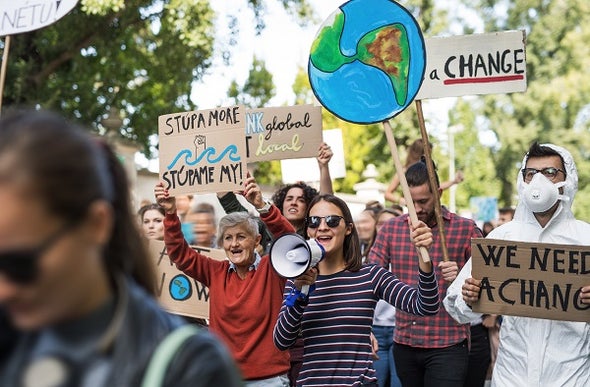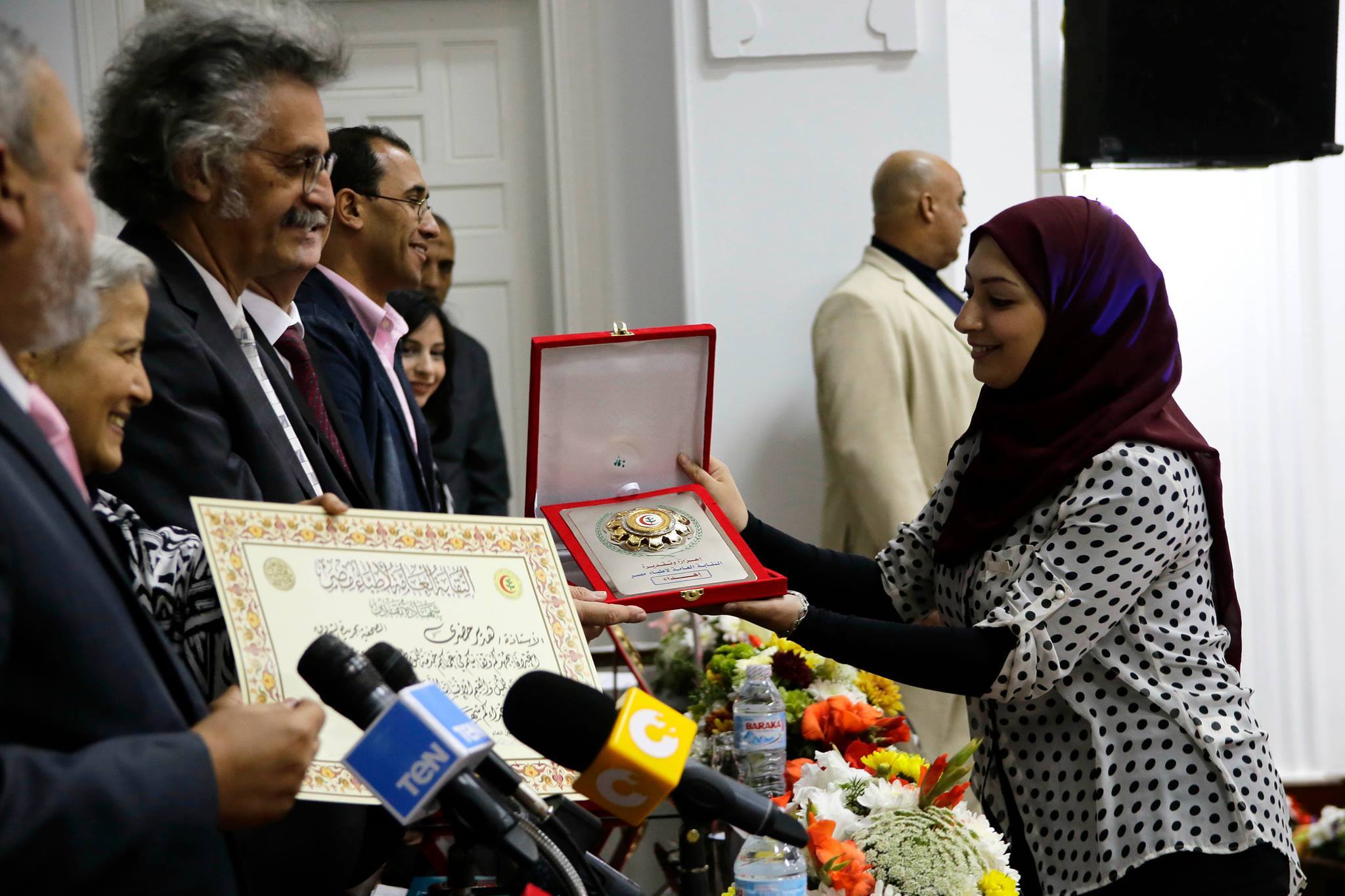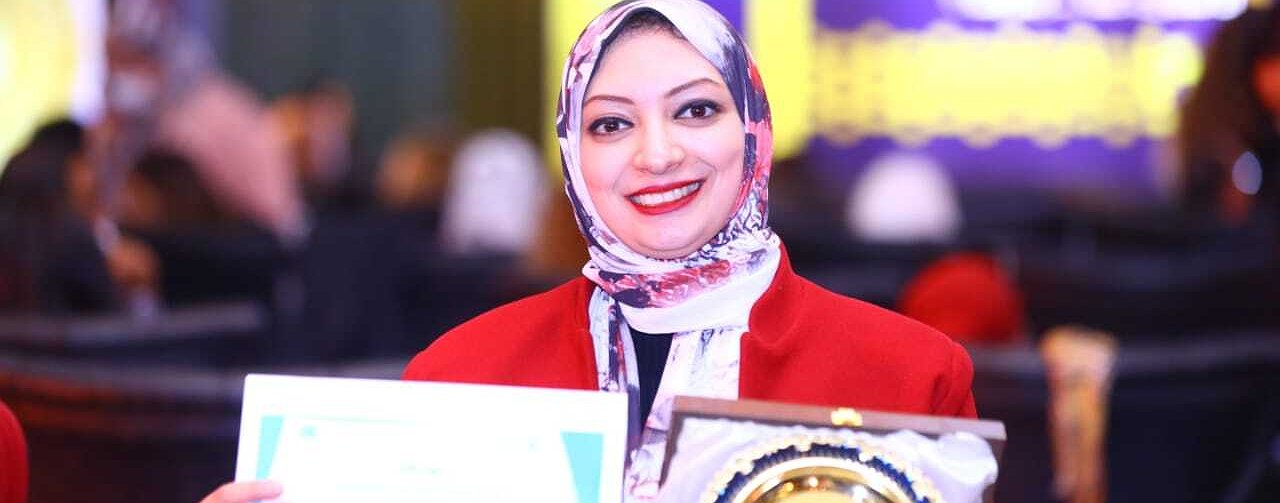When Egyptian journalist Hadeer ElHadary first joined the Marie Colvin Journalists’ Network, she was going through a rough time. The site she was working with had closed down, and similar to other freelance journalists, she felt isolated,marginalised, and she struggled to find work. Then she joined a workshop in Cairo on scientific journalism. That was the beginning of a new phase of hard work, which led to her being selected for a grant from the Climate Tracker to cover the UN Climate Change Conference COP26.
Hadeer AlHadary now writes for the Arabic version of Scientific American “Lil-Ilm” magazine, as well as “Vice” in Arabic, and a number of Egyptian websites such as Al-Shorouk.
What made you choose science journalism and how did you enter that field?
I began working in journalism in 2012 when I was studying media and communications at Cairo University. I was working for Al-Shorouk newspaper covering politics, civil society and human rights, up until I took maternity leave in 2018.
Science journalism is primarily based on scientific reports and research, and presents the reader with sufficient information in a single article.
While on maternity leave, I started thinking about what I wanted to do and my need for change. Science journalism at the time wasn't that popular. In 2020, the Goethe-Institute in Cairo announced that it would hold an intensive programme in science journalism. Some of my colleagues had previously participated in a similar programme, so I applied and was accepted. The two-week programme was an introduction to science journalism, during which we produced some reports. It was after that that I decided to dig deeper into the field.
I got excited about science journalism because it provides documented content. In Egypt, we have a problem with journalism because news is reported haphazardly, and some articles would contain statistics and information from unknown sources. But science journalism is primarily based on scientific reports and research, allowing you to present the reader with sufficient information in a single article.
In addition, I wanted to focus on climate change, which is an area that hasn’t yet received a lot of coverage in Egypt. Working on it is both challenging and fun.
Is it difficult to find outlets to publish your reports, since science journalism is not popular in Egypt?
The biggest obstacle after I finished the workshop at the Goethe-Institute was finding outlets interested in publishing these articles. I didn't find many options in Egypt. Most were either not interested, or didn’t want to pay.
My wish was to be published in “Lil Ilm” (the Arabic version of Scientific American) magazine. So, in 2019 I began contacting them. Each time, they would decline my proposals because they already had enough reporters.
At that time, I was accepted for a Metcalf Institute Fellowship for science journalists at the University of Rhode Island in the United States. That year's topic was about climate change. I didn’t want to waste any time, so I agreed to publish some of my articles on Egyptian outlets for free. My mentor, Rawya Rajeh, advised me against this because it could affect the journalism sector in general, and editors will get used to taking my articles for free. But I told her that I had to do this now in the hope that one day I would be paid for these articles. Publishing articles would also boost my status as a journalist and could open up other job opportunities for me.
Speaking of the Mentorship Scheme career guidance program, why did you specifically choose Rawya Rajeh?
I asked to be introduced to her because I know another member of the network who was very happy with Rawya Rajeh. In addition to her being a mentor, Rawya is like a friend to me, and I am very grateful for her advice and for helping me broaden my thinking. She listens patiently, understands what I am going through, and fully comprehends that “euphoric feeling” that I feel when it comes to publishing articles. Speaking to her encouraged me to get up, to persevere, and not lose hope, because when I met her, I was feeling very frustrated and did not know what my next professional steps would be. The last two months however, there’s been some positive progress in my career.
Rawya is like a friend to me. She listens patiently, understands what I am going through, and comprehends that “euphoric feeling” when I publish an article".
Do you mean when you covered the UN Climate Change Conference Cop26?
Yes, but before that, I was selected to participate in a workshop on biodiversity and ecosystem services with the Africa21 Foundation, during which I produced a report on the extinction of sharks. I won third place and published it in both Arabic and English. I felt that the award was a compensation for my hard work.
At the same time, I was selected for a fellowship with Climate Tracker, a London-based organisation, during which I took training courses for covering the UN Climate Change Conference COP26. The conference was in Glasgow, Scotland, and I covered it from my home in Cairo. It was then that I contacted “Lil-Ilm” again and told them that I would be covering the conference and would be in contact with keynote speakers and ready to report for them. This was the first time in two years that they responded enthusiastically and agreed. I wrote two stories for them.

How did you manage to communicate with the speakers and cover the conference remotely?
I read the agenda of the conference, found the names of the speakers, and started looking them up on other sites like LinkedIn, Twitter, and Facebook. I also looked them up on their official websites; such as universities and companies. I was messaging their employees, and was surprised that the majority, including well-known officials, responded and answered all the questions that I had sent them.
What comes after this conference? How will you build on the achievements and opportunities created by covering it?
It was a special experience and it made me dig deeper and read extensively about climate issues. In the last two months, I’ve been working 16 hours a day. I read a lot and came up with new ideas for stories that I had never thought of before. After the conference, I pitched some of these stories to "Lil-Ilm" magazine and Vice’s Arabic website, and some of them were published. Once you start gaining knowledge on new issues, you will have new ideas. It is also equally important to what type of stories the websites are interested in. For example,: I suggested a light story to VICE about the carbon footprint caused by the making of environmental films because they are interested in such light stories, while I suggested a more complex story to “Lil-Ilm”, about the health risks associated with climate change.
We continue to face challenges in finding platforms that are interested in publishing our articles, especially ones related to science.
One of the most important attributes of working in science journalism is that it allows me to work on an issue that isn’t specific to Egypt. We are competing here within a narrow circle about stories related to Egypt, but science journalism has helped me expand my thinking.
Aside from "Lil-Ilm" magazine and "Vice"Arabic, do you think the local media in Egypt has become more interested in scientific issues? Or has your market remained confined to these two sites?
I am glad that you used the word "market”. Indeed, the local market is still not interested in scientific issues, but this may change soon because Egypt is planning to host COP27 this year. This means that Egyptian media will cover this conference, which may result in greater interest in issues related to science and the climate.
Are there any skills or topics that one needs to specialise in to become a science journalist?
There is a saying in journalism: "Be an expert in your own story". For example, when I heard that a shark attacked a tourist in Hurghada, I asked experts why this happened, and they told me that sharks’ behaviour has been changing lately. So I researched the topic for a month, and discovered that 71 per cent of sharks have already become extinct. That’s where I got the idea about reporting on the possibility of shark extinction.
I might not be an expert in science, but when I work on something, I try to develop expertise in that particular topic in order to properly summarise it for the reader.

When you joined the Marie Colvin Journalists’ Network, you told us at the time that you felt marginalised and isolated. To what degree have things changed, and what challenges do you face today?
When I applied to join the network in July 2021, I was already feeling marginalised after I had lost my job, which was my main source of income, and the site that I was working with was closed down.
The main challenge is still there, but the level of difficulty changes from time to time. At the moment, we - as women freelance journalists - continue to face challenges in finding platforms that are interested in publishing our articles, especially ones related to science.
When I joined the network, I was looking for platforms to publish my articles. I was also trying to find a way to balance the responsibilities of motherhood, personal and professional frustrations, and the desire to keep on moving. I feel like I've made progress because I never stopped trying. Simply seeking out and applying to join the Marie Colvin Journalists Network, and joining the Mentorship Scheme, was in itself an attempt to get rid of any sense of failure.
Simply seeking out and applying to join MCJN, and joining the Mentorship Scheme, was in itself an attempt to get rid of any sense of failure.
Hadeer's advice to members wishing to enter the field of science journalism:
- Be an expert in your own story: be patient while searching for information and studies related to your story, in order to be an expert in it. You must have sufficient knowledge and information to be able to write a good and interesting story in as few words as possible.
- Put people at the centre of your story: From my short experience in science journalism, the first challenge was trying to communicate complex scientific information in a seamless manner. I've found that stories become special when they show how the topic in question can affect people's daily lives, their security, food, and future.
- Don’t give up on your ideas: try to categorise your suggestions and pitch stories to each platform according to what suits them. Don’t feel defeated if your ideas are rejected, but try formulating them in a different way or sending them to other platforms. It's also important to excercise due diligence before pitching your idea to the editor and convince them that you’re confident about it, and therefore deserve the opportunity to work on it.
- Write down your thoughts so that you don’t forget them: Ideas will cross your mind in passing, especially while you’re working on another story. It’s best if you write them down in your diary, or in a file on Google Drive, so that you can return to them when the time comes to work on something new.
